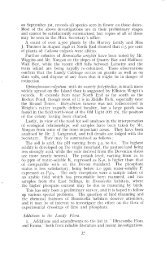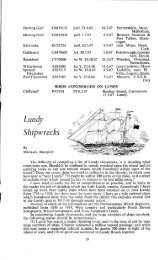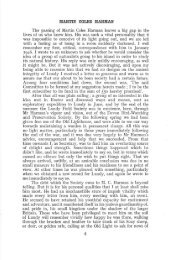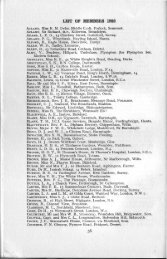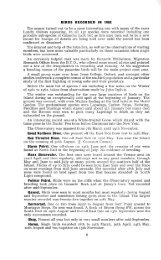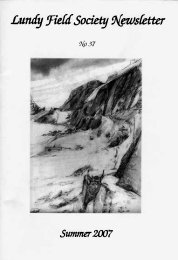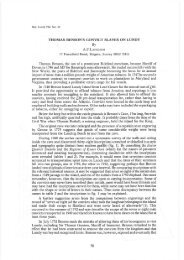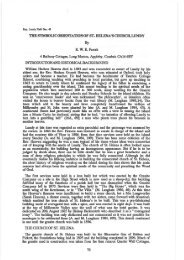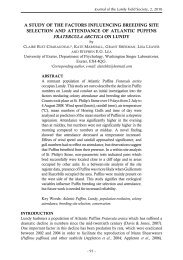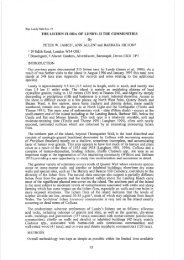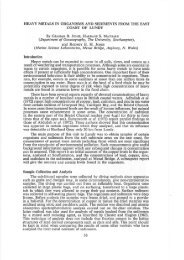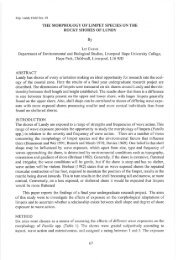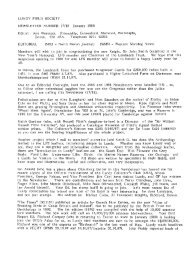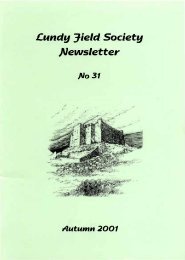Create successful ePaper yourself
Turn your PDF publications into a flip-book with our unique Google optimized e-Paper software.
Irving, RA, Schofield, AJ and Webster, CJ. Island <strong>Studies</strong> (1997). Bideford: <strong>Lundy</strong> Field SocietyISLAND STUDIESunrecorded elsewhere (Wright 1968).A report in 1980 by Mr Rob Randall tells how hefailed to find purple spurge Euphorbia peplls (Randall1980). He also examined the status of balm-leaved figwortScrophularia scorodonia, which was becomingrare on the north coasts of Devon and Cornwall, butwhich was still flourishing on the east coast of <strong>Lundy</strong>.Fungal species are listed in the 14th, 21st, 22nd,23rd, 38th,, and 43rd Annual Reports. Lichen speciesare listed in the 3rd, 13th and 23rd Reports, with amajor lichen survey currently being undertaken byPeter James and Anne Allen. Liverworts are reported inthe 13th and 26th Reports; and freshwater diatoms inthe 3rd Annual Report.TreesWith the help of Mr W.H. Dyer I surveyed the treesfound growing on the island in 1969 and 1970. 433trees were counted in the eight main wooded areas,which were all on the east side. Sycamore Acer pseudoplatanuswas by far the most successful species andshowed the most signs of regeneration. ElderSambucus nigra, willow Salix atrocinerea·and S. capreaand ash Fraxinus excelsior were the next most numerous.All trees showed signs of wind damage where theywere unprotected by the bulk of the island. During thesummer of 1970, beech Fagus sylvatica, sessile oakQuercus petraea and three species of pine Pinus spp.,were planted on the north side of Millcombe in thememory of Albion Harman.145Tree planting has taken place since then and thereare two reports of this. Further planting was undertakenin 1983 in Millcombe Valley, StJohn's Valley, northof the Ugly, and St Helen's Copse. Trees have beenplanted to replace mature and dying trees and also innew areas in the hope that they will support wildlifeand the expectation that they will enhance the beautyof the island. The species chosen were mainly thosealready growing on the island, but field maple Acercampestre, aspen Populus tremula and a strawberrytree Arbutus unedo were also planted. A.J. Parsonsquestioned the wisdom of planting trees in St John'sValley, holding that its ecological importance lay in itsopen nature. P. de Groot replied to this in I984 sayingthat the Pinus muricata, which had been planted closeto the edge of the road to provide shelter, had not faredwell and many had died. The aspen and alder hadbeen planted to provide shelter for birds.Management studiesIn 1988, the then warden Neil Willcox, in conjunctionwith the Committee of the <strong>Lundy</strong> Field Society, producedthe first draft of A Management Plan for <strong>Lundy</strong>(Willcox 1988); this was developed over the next fewyears. In 1994, English Nature published a managementplan for the Marine Nature Reserve together withthe island's Site of Special Scientific Interest, entitledManaging <strong>Lundy</strong>'s Wildlife (English Nature 1994).An important addition to the botanical studiesmentioned above was the survey of the island's floraCopyright (1997) <strong>Lundy</strong> Field Society and the author



